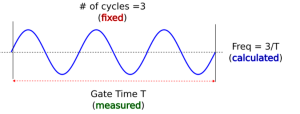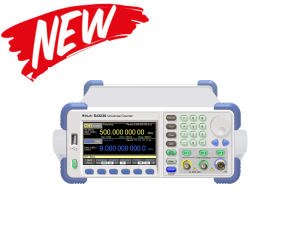S43230 Series High Precision Universal Counter
What is a frequency counter?
Frequency counters accurately measure the frequency of signals with waveforms such as sine waves, square waves, triangle waves, sawtooth waves, or other regularly repeating patterns. These instruments can measure the frequency and timing characteristics of both analog and digital signals.
Do you need a frequency counter? Frequency Counters vs. Oscilloscopes and Other Devices:
Other instruments, such as oscilloscopes, spectrum analyzers, and frequency meters (like old analog pointer meters), can also measure frequency. However, frequency counters excel in their precision and accuracy. While other instruments measure frequency and other characteristics from digitized data using software, frequency counters use carefully designed hardware circuits to accurately measure these parameters directly on the input signal. In addition, keep the following in mind when selecting an instrument:
1. Frequency counters provide high-precision and high-resolution measurements, even at frequencies up to GHz.
2. Frequency counters work better with continuous wave signals; software-based measurements work better with pulsed signals.
3. Frequency counters can be used reliably for long-term frequency measurements.
4. Frequency counters are simpler and faster to use than oscilloscopes or spectrum analyzers.
Frequency counter types by function
The main classification method is based on the target industry and function.
Universal counters: Many customers prefer an all-in-one universal counter over a simple frequency counter because, in addition to supporting frequency measurements, it also has common auxiliary measurement functions, such as signal timing measurements. It can usually measure:
Frequency: refers to the number of complete cycles completed per unit time.
Period: refers to the time interval between a complete cycle of a signal.
Frequency ratio: used to measure the frequency ratio of two input signals.
Time interval: measures the time delay between two input signal events.
Time interval error: measures the timing variation relative to the expected or ideal value.
Pulse width: measures the duration of a pulse, usually the duration of a digital signal’s high level.
Rise and fall time: refers to the time it takes a digital signal to transition from a low state to a high state and from a high state back to a low state.
Phase angle: measures the phase difference between two input signals.
Duty cycle: refers to the percentage of a signal (usually a square wave) that is high in one complete cycle.
Voltage: reports the maximum, minimum, and peak-to-peak voltages of a signal.
Signal power: Some universal counters have built-in power meters that can report signal power.
In addition, these instruments support more advanced statistical and analytical functions, such as:
(1) Plotting histograms to view the distribution of frequency measurements and detect stability or noise issues.
(2) Plotting frequency trend graphs to detect problems such as frequency drift.
(3) Counting frequency measurements to detect signal jitter.
(4) Accumulating frequency readings.
(5) Calculating Allen deviation to measure frequency stability.
RF counters: RF counters, also known as microwave frequency counters, are widely used in RF engineering. They can measure frequencies ranging from a few kilohertz (kHz) to hundreds of megahertz (MHz) and even up to tens of gigahertz (GHz). For example, the Keysight 53230A Universal Counter/Timer has a measurement limit of 350MHz for the basic model, while the advanced model can measure up to 15GHz. RF counters are constructed differently because digital circuit elements (such as triggers) are too slow to keep up with the high-speed switching of GHz-band radio signals. Therefore, RF counters use prescalers or other frequency reduction components to first reduce the frequency of the input signal to the MHz range.
Counting timers: These counters, also known as time interval analyzers, are optimized for accurately measuring time intervals.
Modulation domain counters: These counters are specifically designed to analyze modulated signals, in which the carrier signal is periodic, but this periodic pattern is masked by the frequency modulation scheme.
Frequency counter types based on appearance
Frequency counters can also be divided into the following types based on appearance and interface:
Benchtop instruments
Handheld instruments
Hardware modules for modular test equipment
Embedded modules for ASICs
Logic modules in FPGAs
Which industries use frequency counters?
Different types of frequency counters are used wherever high-precision frequency and timing measurements are required, which is the case in the following industries.
Electronic Component Manufacturing: Accurate frequency and timing measurements are essential for quality control of several electronic components such as oscillators, phase-locked loops, clock modules, analog-to-digital converters, timer circuits, dividers, etc. In these industries, frequency counters are used as test equipment.
Defense: RF counters are used for quality control of critical radar and sonar systems.
Global Navigation Satellite System (GNSS): GNSS satellite constellations like the Global Positioning System rely heavily on precise timing and frequency characteristics.
Telecommunication Systems: Similarly, in wireless communication equipment such as 5G base stations, frequency counters are used to achieve precise timing and frequency characteristics.
How a Frequency Counter Measures Frequency
Frequency refers to the number of complete cycles a signal completes per unit time. There are two main methods for measuring frequency.

Direct Frequency Measurement Technique: The first method is called direct frequency measurement technique, which simply counts the number of cycles completed in a fixed time interval (called gate time). Here is how it works: A high-precision clock called a time base is responsible for gating, that is, measuring the number of cycles completed in a fixed gate time interval. It then divides the measured number of cycles by the gate time to get the frequency. There are some obvious disadvantages to this method: the gate time does not necessarily coincide with the signal period, which may lead to inaccurate cycle number measurement; for low-frequency signals, each cycle may last for a long time, and the counter needs to set a long gate time to accurately measure the number of cycles.

Reciprocal measurement technique: Another better method is the reciprocal measurement technique. Unlike the direct frequency measurement technique, the reciprocal measurement technique does not count the number of cycles completed within a fixed gate time, but waits for a fixed (internal configuration) number of cycles to complete, and then uses a high-precision internal or external time base to accurately measure the time required to complete these cycles. This time is the gate time. Finally, it calculates the frequency by dividing the number of cycles by the measured gate time. It is called the reciprocal measurement technique because it first measures the time of each cycle and then takes its reciprocal to calculate the frequency. The advantages of the reciprocal measurement technique include: the same number of bits of frequency resolution can be obtained regardless of whether the input frequency is hertz or gigahertz; it has high accuracy at both very low and very high frequencies. However, frequency counters using the reciprocal measurement technique are more expensive to manufacture.
What are the key components of a frequency counter?
The high accuracy of a frequency counter is due to its components, which are listed below.
Precision Timebase: The timebase is an internal clock and gating circuit used to accurately measure periods or timing, depending on the measurement technique. It is usually one of the following crystal oscillator circuits:
Room Temperature Crystal Oscillator: Uses a simple quartz crystal that maintains a fairly stable frequency at room temperature and is suitable for non-critical applications.
Temperature Compensated Crystal Oscillator: Maintains a stable frequency by compensating for temperature fluctuations caused by operating conditions or environmental changes.
Oven Controlled Crystal Oscillator (OCXO): Also known as a high stability oven timebase, this oscillator is placed in a small oven to achieve high stability and accuracy by maintaining a constant temperature. The timebase is susceptible to timebase errors caused by aging and temperature effects. Meticulous maintenance and regular calibration are necessary to maintain the highest stability and accuracy over the long term.
Input Amplifier, Attenuator, and Prescaler: These components are used to condition the input signal to match the counter circuit. They can amplify weak signals, attenuate strong signals, block high-frequency noise, and achieve impedance matching. RF counters must ensure that high input signal frequencies are reduced so that downstream digital circuits can keep up with the signal’s transition speed. For this reason, they use high-speed prescalers, transmission oscillators, or heterodyne converters.
Trigger or comparator circuit: The trigger circuit is used to accurately determine the start and end of each cycle of the input waveform.
Counting circuit: This circuit is where the actual cycle counting and time measurement takes place. It consists of digital logic circuits, including components such as flip-flops and NAND gates, which are activated each time the input signal exceeds the trigger level.
Microprocessor: The microprocessor is used to control the operation of the frequency counter, store and transmit data, perform statistical and other analysis, and communicate with the user or other devices.
Power supply: The frequency counter uses a high-quality power supply with very low ripple and noise.
Interface circuits and external interfaces to other devices: Most modern frequency counters can be connected to personal computers and automated test equipment through the following input/output interfaces:
General Purpose Interface Bus (GPIB): This is a hardware and data exchange standard for connecting programmable instruments to computers. It includes the Standard Commands for Programmable Instruments (SCPI), which specifies a set of commands and semantics for each type of instrument.
Universal Serial Bus (USB): The frequency counter can transfer measurement data to a USB storage device.
RS-232: This serial bus can be used to transfer data to a computer in a custom binary format.
LAN Extensions for Instrumentation (LXI-C): This is an Ethernet-based SCPI protocol that supports browser control of the instrument.
Display Circuitry: If the frequency counter is a stand-alone instrument, it is usually equipped with a liquid crystal display (LCD) and display circuitry to display measurement results, analysis results, and graphical outputs such as histograms.
What are the key specifications of a frequency counter?
When selecting a frequency counter, the following key specifications are important to look at:
Number of input channels
Frequency range and maximum frequency for each channel
Frequency resolution, the number of digits that indicate the accuracy of the frequency measurement
Time resolution, the smallest time difference between two events that can be measured in a single measurement, usually in nanoseconds or picoseconds
Phase resolution, in degrees
Time base error, time base aging factor (in ppm or ppb per year), and time base uncertainty
The rate at which data is transferred to an external interface
Tips for achieving high precision and accuracy
Follow these tips to make precise measurements with a frequency counter:
Avoid using the automatic trigger mode, which has low accuracy. Using other trigger modes, such as external trigger, time trigger, or digital trigger, can improve time resolution and system uncertainty, thereby reducing overall measurement error.
Always keep the time base powered on so that it is in a warm-up state. This can improve the annual aging rate by an order of magnitude compared to periodically powering it off.
Use the best time base possible. High-stability, temperature-controlled time bases do not require frequent calibration, but for time bases with poor stability, regular calibration is recommended.
Pay attention to trigger level and trigger level timing errors, especially when the signal is noisy.
Lock all time bases to the same clock to avoid signal jitter caused by independent time bases.
Set the trigger level so that it intersects the signal at the point where the signal slope is the largest to minimize the response time of the trigger condition.
Do not set the trigger bandwidth too narrow to prevent noise from being misinterpreted as a zero crossing.




